Hal Jespersen's Battle of the Bulge Tour, December 2023
This is my (Hal‘s) report on my trip to Belgium and Luxemburg for a tour of the Battle of the Bulge, hosted by Stephen Ambrose Historical Tours. (And there is also some traveling in France before the start of the Ambrose tour.) It is my fourth tour with Ambrose, the first being the 75th anniversary of D-Day in 2019, followed by Patton’s advance across France and Belgium to Germany, then the Italian Campaign from Sicily to Rome in 2022, and then most recently, the World War I Western Front in November. Because this report is so large I have broken it into three parts:
- Part 1: Activities on my own before and after the Ambrose tour (Paris, Saumur tank museum, Brussels, Paris)
- Part 2: Northern Shoulder (Peiper, St. Vith, Spa, Belgium) — this page
- Part 3: Southern Shoulder (Bastogne, Diekirch, Luxembourg)
Maps
I created two maps to aid me through my travels. The first is of northwestern Europe, identifying important rivers and many place names that are relevant for the Ambrose tours I have taken. The second is the Ardennes region for the Battle of the Bulge, with the opening positions of the opposing forces. Clicking on either map will download the PDF version.


Monday, December 11 — Northern Shoulder
I met the group in the lobby of the Crowne Plaza Airport Hotel. Chris Anderson (the historian on our WWI tour) is back again, as is Klaas the bus driver, but our tour manager, George Luz, Jr, is new to me. (George’s father was in Easy Company, 506th Parachute Infantry Regiment and the HBO TV series, Band of Brothers.) There are 23 guests. Our bus is magnificent—brand new with super legroom! We started off at 11 for a three-hour drive and along the way watched an episode of the 1973 series World at War, narrated by Lawrence Olivier, covering May–August 1944. I hadn’t seen this in a long time and found it quite good. Oddly, Chris chose not to show any of the following episodes.
Today we’re concentrating on the northern shoulder of the battle. Our first stop was right on the German border outside the town of Hollerath, where on December 16, the 393rd Infantry Regiment of the 99th Infantry Division was caught by surprise receiving a massive German artillery barrage at 5:30 AM, but managed to delay the German onslaught by a day. This was right on the forest road that was designated Rollbahn A, one of five planned avenues of German advance, and it was instructive to see how narrow and difficult this would have been for large tanks. There were a large number of dragon’s teeth obstacles still in the surrounding fields, remnants of the Siegfried Line. We gathered around a small marker that memorialized the 99th on one side and their attackers, the 277th Volksgrenadier Division, on the other, and then explored still-visible foxholes in the woods.





Next we stopped in the village of Hünnigen, still on the border, along the road known as the International Highway. Chris described an action in the 2nd Infantry Division area where an artillery forward observer took up station in the church steeple and called in large American artillery strikes only 100 yards away from his lines. Then we were not far away from the twin villages of Krinkelt/Rocherath, where the 99th Infantry Division put up a fierce defense December 17–19, destroying up to 100 panzers, wrecking the 12th SS Panzer Division. After this setback, the Germans redirected the thrust of their attack from the northern 6th SS Panzer Army to the center 5th Panzer Army. (In my opinion, the action in the twin villages was the key point that meant the overall battle was lost for the Germans.)
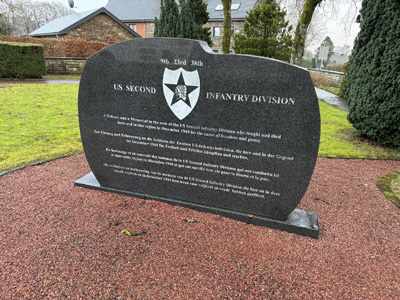
On the outskirts of the twin villages are the Lausdell Crossroads, where the 1st Battalion/9th Infantry commanded by Lt Col William D. McKinley (kin of the former president) put up a defense “at all costs.” Of his 600 men, two thirds were lost in the defense. We heard about the exploits of PFC William Soderman, who received the Medal of Honor for taking out three Panther tanks with a bazooka. As the daylight was almost gone after 4 PM, we adjourned from the battlefields and drove to our hotel in Spa, Belgium, the Radisson Blu. Dinner was in the hotel and it was excellent.
Tuesday, December 12 — Kampfgruppe Peiper
Today we followed the infamous path of Lt Col Joachim Peiper’s Kampfgruppe, the spearhead of the 1st SS Panzer Division. It feels strange to board the bus at 8 AM in total darkness, and this morning is pretty foggy, which is actually good news because that means there will be little of the wind that makes the mid 40s seem so cold. Peiper, formerly Heinrich Himmler’s aide, was given a strong, modern tank force and his advance was intended to be the schwerpunkt of the entire German offensive. We drove south east for about 80 minutes and while we were on the bus, Chris gave us an overview of some of the important personalities, including Sepp Dietrich, the 6th SS Panzer Army commander and former bodyguard to Adolf Hitler. He explained that the orders for the Ardennes offensive included a plan of terrorism against the US troops and the local civilians, so that the multiple massacres we would hear about this week were not simply isolated incidents. He also explained the backgrounds of Peiper and Otto Skorzeny, Hitler’s favorite commando leader, who led the infiltrators who dressed up in American uniforms to seize bridges and disrupt the rear areas in advance of the German main thrust.
Peiper’s route took him west through the Losheim Gap on the boundary between the 99th and 106th Infantry Divisions, and of the V and XIII Corps, an organizational weak spot in any defensive line. These two brand new divisions were stretched out very thinly and the only other unit of note was the under strength 14th Cavalry Group. We started off just across the German border in Losheim, where Peiper’s 25 km-long column assembled. Here we saw the first bridge that had to be crossed and it was damaged, which held up Peiper for almost the entire day of December 16. Since his plan required him to reach the Meuse River within two days, this was an extraordinarily bad start.
Next was a hill just above the town of Lanzerath, Belgium, where 18 men of an intelligence and reconnaissance platoon under Lt Lyle Bouck held off attacks of 500 men from an elite parachute battalion for almost a day. Amazingly, none of the American soldiers were casualties until they had to surrender for lack of ammo. Lt Bouck was transported to Hammelburg, the famous POW camp that Patton’s troops, Task Force Baum, attempted to raid late in the war. One of the guys on the tour had a father who was also captured in this area and went to the same POW camp, so he was able to provide interesting commentary along the way about locations we saw.
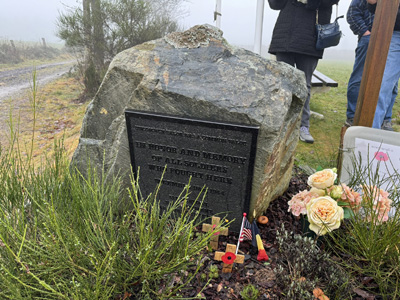
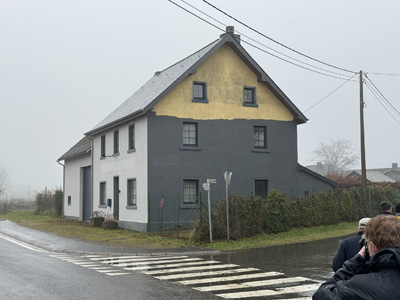
Little was made of this episode until after the war when Eisenhower’s son mentioned it in his book, and belatedly a number of medals and unit citations were awarded, making this platoon the most decorated of the war. We were able to look into the woods to see the foxholes that still exist, and Chris said that documentation is available so that each hole could be attributed to a specific soldier. It is interesting to note that when we arrived there was a platoon sized group of Dutch soldiers who seemed to be on a staff ride or something similar.
Next was the town of Honsfeld, which was a warming station and a generally relaxed rear area, unsuspecting of the threat the Germans posed. We saw an S-shaped bend in the downtown street that delayed Peiper’s tanks. This was the first of the multiple places where a massacre occurred, here with 20 victims. Then to the town of Büllingen where there was sporadic fighting and Peiper was able to seize a small quantity of fuel for his tanks. Moving along, we reached Malmedy, where Lt Col David Pergrin, commanding the 291st Combat Engineer Battalion, was the only defender of the town. Chris described how three survivors of the Malmedy Massacre were able to reach the engineers’ roadblock and describe their ordeal. And then we backtracked to the road junction at Baugnez to see the field, across the street from an auto dealer, in which that massacre occurred, where 113 soldiers of the 285th Field Artillery Observation Battalion stumbled upon the Germans and surrendered, only to be mowed down in captivity by three machine guns, and finished off by individual shots to their heads.

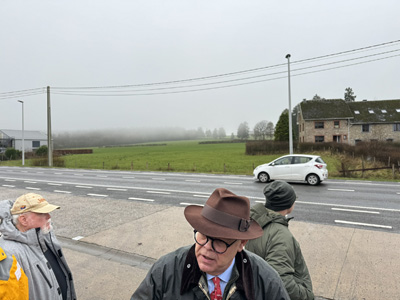
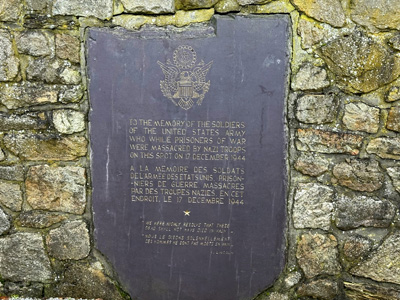

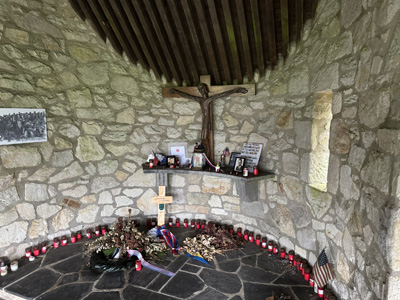
The town of Bellevaux–Ligneuville followed, and there is a monument to eight soldiers from the 49th Anti-aircraft Artillery Brigade who were murdered here. In the pretty town of Stavelot, we saw the bridge that was critical for Peiper to use to cross the Amblève River. He encountered a lot of resistance in the town and was not able to cross until late on December 17. The US engineers were able to destroy the bridge on the 19th, which prevented the other Kampfgruppen of the division from crossing behind Peiper. There is a monument close to the bridge with a US M3A1 halftrack and we took a group picture.
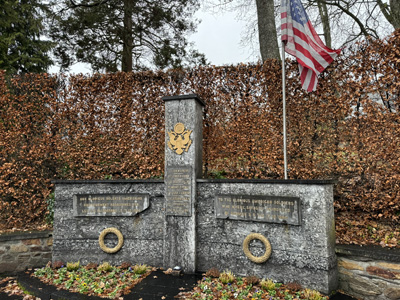


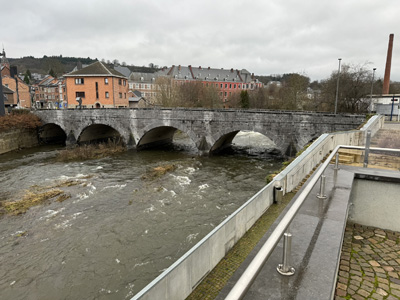
In the town of Trois Ponts, there are actually three highway bridges—two over the Salm and one over the Amblève, and Peiper was not able to use any of them, foiling his attempt to reach Werboment. Some US air support was available this day, December 18, and Peiper‘s men endured a two hour attack by 16 planes while they were floundering around looking for a usable bridge. I was impressed by how difficult the terrain in this area is, forested hills with deep river valleys, restricting vehicle traffic to very narrow roads. Peiper’s final chance to find a bridge was in the town of Stoumont, and there was one bridge of a temporary nature still intact, but a courageous sergeant of the 291st retrieved the detonator from the middle of the bridge while he was under machine gun fire and destroyed it. Peiper’s curses about “Those damned engineers” became the motto of the battalion. This was the end of Peiper’s advance.

Our final stop of the day was in the town of La Gleize, where we were greeted by a magnificent King Tiger tank on display in front of the December 44 Museum. The museum is quite good, with hundreds of artifacts, weapons, and well preserved uniforms. (They could have used more maps and other displays to describe the sequences of the battle in this area.) I enjoyed a relatively brief film that contained lots of footage of panzers maneuvering in the battle as well as their remains after the battle. Then it was back to nearby Spa and another group dinner in the hotel.



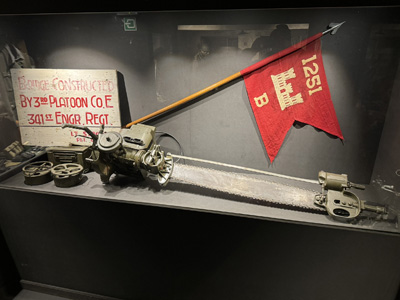
Wednesday, December 13 — St. Vith and 106th Infantry Division
We stopped briefly at the former Hotel Brittanique, the HQ of the First US Army in Spa. Chris talked about Lt Gen Courtney Hodges’s reaction to the initial moves of the German offensive, retreating the HQ west in anxiety about Peiper’s advance, and the controversies around Eisenhower’s decision to transfer the First and Ninth Armies temporarily to Montgomery’s 21st Army Group. And he described the famous Verdun conference where Patton boasted about how quickly he could attack the southern shoulder of the bulge.

We drove about 30 minutes to St. Vith and stopped at the HQ site of the 106th Infantry Division, which is no longer the same building, but there is a modest monument. The 106th was a totally green division and was told to occupy a line 10–12 miles long, over twice the normal front for a seasoned division. Two regiments, the 422nd and 423rd Infantry, occupied Skyline Drive on the Schnee Eifel and they were unlucky enough to be in between two roads, which the Germans used to double envelop them. The 106th commander, Maj Gen Alan Jones, eventually broke down and turned command of the entire area over to Brig Gen Bruce Clarke of Combat Command B, 7th Armored Division; that full division was slowly approaching from the west to attempt a relief of the 106th. We discussed how Hasso Manteuffel’s 5th Panzer Army was better prepared for their initial assault than Sepp Dietrich’s 6th SS, having done reconnaissance (contrary to Hitler’s orders) and infiltrated close to the thin US lines. The US pulled out of St. Vith on December 22; by this time it was under command of the XVIII Airborne Corps.
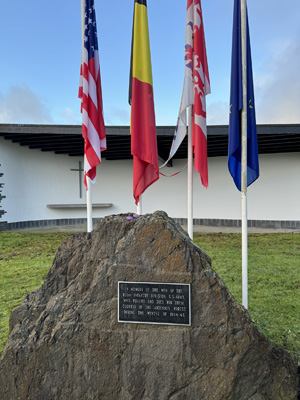
Close by was Prumer Berg, where there is a monument to the 168th Combat Engineer Battalion, who were sacrificed in a doomed defense, but one that bought needed time. We walked into the muddy woods to see some poorly defined foxholes they used. There is a small monument in the woods to Capt Eric Fisher Wood of the 589th Artillery Battery, who fought his unit valiantly, but in the chaos of withdrawing units, got separated. His body was found in January, surrounded by 11 dead Germans.

In a lovely farming area near the village of Wereth, we stopped at a series of monuments to the “Wereth 11,” eleven Black soldiers of the segregated 333rd Field Artillery, who were brutally tortured and murdered by the SS. Sadly, no official Army investigation was conducted and no one was punished for this outrage.
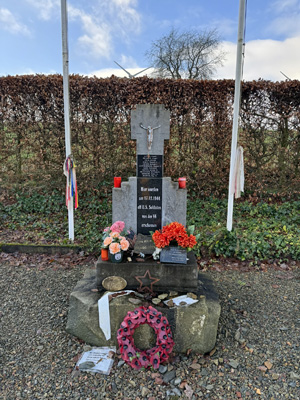
At a crossroads in the village of Poteau, we heard about an epic engagement between Task Force Mayes of the 14th Cavalry Group and Kampfgruppe Hansen of the 1st SS Panzer Grenadier Regiment, which has famously been filmed, as shown in the YouTube video:
We had lunch on our own in St. Vith, where there is a plethora of choices on the main drag. I ate with a group in An der Linden restaurant, eating a delicious plate of Boulettes Liégeoises (meatballs) avec frites. And in rushing back to the bus, I managed to forget to leave with my hat. Grrr.
We drove past the village of Schönberg into the hills and then marched up a very steep dirt road to Hill 536, where the 423rd and 422nd regiments surrendered. Many men had attempted to escape down the hill toward the village, but they ran into a Sherman tank that had been captured by the Germans, so they had to turn back. The two regimental colonels agreed to order their 7000 men to surrender, the largest such surrender in the ETO (but smaller than Bataan). We had a lengthy discussion of the practicalities of surrender and how difficult it must have been, considering the rumors the men had heard about the German atrocities against prisoners further north.
Into the village of Schönberg, we heard stories of the chaos of vehicles trying to escape through the crammed streets, and incidents of US soldiers mistakenly approaching US vehicles that had actually been captured by Germans. Then we zipped across the German border to the town of Bleialf where we stopped at a church that had repaired battle damage. There was also a monument to the WWI dead. We were just south of the 423rd’s position and Chris described how the 18th Volksgrenadier Division streamed into town from Prüm to effect half of their double envelopment. We had a nice view of the Schlee Eifel and the Siegfried Line to the east.

We drove up and along the Schnee Eifel past the Schwarzer Mann, a point 2,290 feet high. Although we had a very pleasant morning, the afternoon brought some light rain so our visibility from the heights was limited, but the Skyline Drive was mostly lined with trees anyway. It was about an hour back to Spa and then we had dinner on our own. I ate with some new friends at a “Canadian pizza” place.
Thursday, December 14 — 28th Infantry Division Defense and Luxembourg
The forecast today is decent, but we started off in the dark with heavy fog and cold drizzle. (I have learned this fall that Northern European weather forecasts are pretty unreliable, changing multiple times per day and often unaware of current conditions.) After the bus left we had to turn around and return to the hotel for an item left behind in a room safe. (Now I don’t feel so silly losing my $15 hat in the restaurant yesterday.) As we resumed a long bus ride, we watched two episodes of Band of Brothers, Bastogne and Foy.
We crossed into Luxembourg for a while and then drove right up to the German border across the Our River from Dasburg. We talked about the 5th Panzer Army strategy and saw the site of the main bridge over which four columns of panzers and panzer grenadiers had to cross. The bridge had been destroyed earlier in the autumn, so the infantry crossed first in boats while a temporary bridge was built, which took most of the day. On this side of the river were two battalions of the 110th Infantry Regiment, spread out in four villages and in small OPs over much too wide a front. The 28th Infantry Division, their parent unit, had been almost wiped out in the Hürtgen Forest fighting that fall and was located here essentially to rest and regroup in a quiet sector.

Our next stop was one of those four villages, Hosingen. It’s really rough country on the way up. Co K of the 110th had 270 men here and a few Shermans of the 707th Tank Battalion. There is a massive water tower, reinforced concrete with a steel interior, that was used for directing mortars and some limited artillery. The company held out the 16th with relatively small losses, but by the 17th the panzers were over the river and up the hill. Nearby was the Café Schinker Crossroads, where about 100 German infantry were killed at close range by two American halftracks mounting quad-50 caliber antiaircraft guns. At Marnach, where Co B fought, we stopped to see some very detailed signs about the fighting here and the organization of the 707th Tank Battalion, which on December 17 engaged 18 tanks and lost them all. I found an error in one of the signs, where a photo of a Sherman model was identified incorrectly (they called it an M4A1E8, but it had a welded hull and VVSS suspension—tsk, tsk).


Next was Clervaux (German name Clerf), which a very dramatically set small city in a deep valley with lots of interesting architecture. We stopped at the HQ of the 110th Infantry Regiment, marked by a bust of their commander, Col Harley Fuller. The German reached here by the 17th and since there were no bypass roads, had to assault the city. Our guys held out until the 18th, including a last stand at the castle. Survivors streaming west (which was depicted in Band of Brothers episode 5) were later gathered into a Team SNAFU. Gen. McAuliffe later said that he could have never defended Bastogne without the delaying sacrifice of the 110th, which suffered 2750 casualties (out of about 3000).

We climbed up a lot of steps to the castle and talked about the fighting there. The castle is a handsome building that looks more like a ritzy old hotel than a place Cinderella would stay. It currently has town offices and a photography museum. The Germans had to use Panzerfausts and an assault gun to batter in the castle door. Chris said the Rock Hudson film Castle Keep is loosely based on this action. There was Sherman A3 knocked out there, and it has been on display in the courtyard, but is currently vacationing in the Bastogne vehicle restoration center. On an adjacent steep hillside we could see a large white house the Germans used to direct fire in the battle.
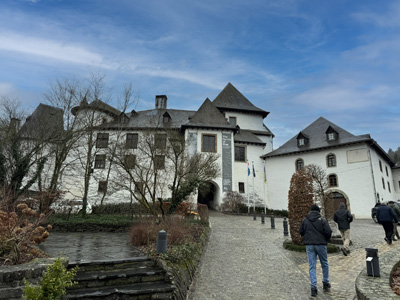
Then on toward Bastogne. As we munched on another bag lunch, Chris talked about all the units scrambling to reenforce the critical road junction town: the CCR 9th Armored Division, CCB 10th Armor Division (Third Army), and the 101st Airborne. The original plan was for the 82nd Airborne to take Bastogne, but they were redirected north to St. Vith. We stopped at a church in the village of Longvilly to discuss the roadblocks set up by the 9th. Then the Grotto of St. Michael, where Team Cherry of the 10th held up the Panzer Lehr Division for six hours, losing dozens of tanks and 175 men.
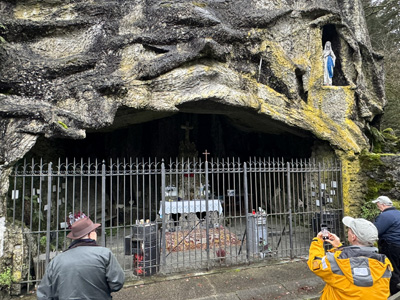
In Bastogne proper, we stopped briefly at a building on the Avenue de la Gare, von Runstedt’s HQ in 1940. Chris showed us a photo of Hitler visiting on his way to Paris. Down the street is the 101st Airborne Museum, which is a great collection of maps, battle info, diaramas, and thousands of artifacts—not only recovered battle gear, but also all the daily stuff of life, like rations, cigarettes, medical gear, etc. There’s a room in the basement where they simulate the sights and sounds of being bombarded by artillery. Impressive. There were a few actual veterans of the battle on hand for commemorations over the weekend.
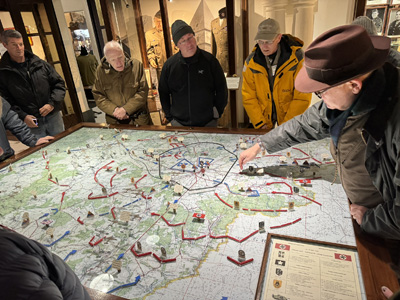



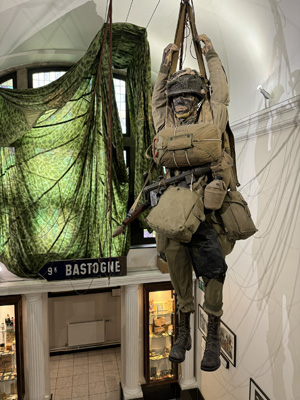
We made a brief stop in Houffalize to visit a magnificent Panther tank Ausf. G, #111, of the 116th Panzer Division. It served throughout the Western Theater from Normandy on until it met its untimely end when it fell off a bridge here in town. It was restored in Bastogne and looks great, although I am told that the interior is a complete loss. Chris also described the Allied bombings of Houffalize, mostly Lancaster heavies, in late December and early January, designed to fill the roads with rubble to restrict German movements. This was at no small cost to the homes and inhabitants of the cute little city. We concluded by driving back to Clervaux and the Hotel Koener, our digs for the next three nights. Dinner was decent Italian fare in the hotel restaurant.
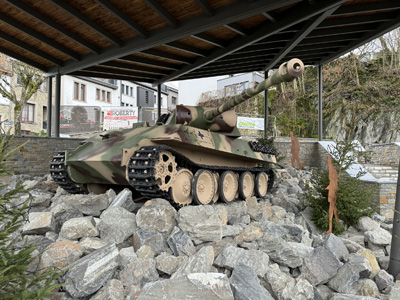
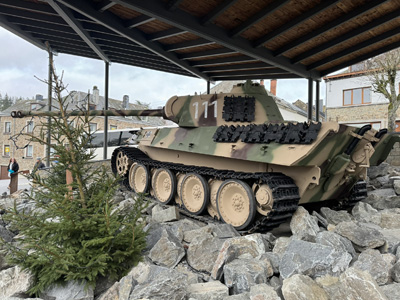

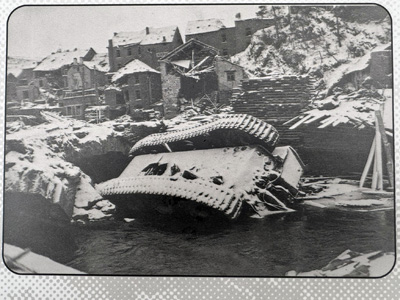
Go to Part 3, the Southern Shoulder.